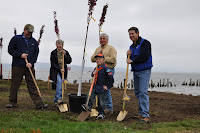
Graham Oaks Nature Park opened September 18 in Wilsonville, marking milestone for Metro’s voter-approved Natural Areas Program.
The 250-acre park features restored oak woodlands, three miles of trails and a rich cultural history.
Three miles of trails lead visitors through restored oak woodlands, wetlands and a conifer forest rich with wildlife – and a legacy of Native American tribes and farmers who once used this land.
Two voter-approved natural areas bond measures allowed Metro to purchase and restore the 250-acre site, and develop it as one of the region’s most sustainable parks. Graham Oaks is the third major park opened by the Metro Natural Areas Program – and one of the region’s largest new parks in several decades.
“At Graham Oaks, returning to the past is creating a better future for Wilsonville and the surrounding community,” said District 3 Metro Councilor Carl Hosticka, who represents the area. “Visitors will experience the oak trees, wildlife and sense of serenity that defined this landscape centuries ago.”
Before the land was logged and farmed, birds flocked, mammals prowled and camas lily bloomed. Kalapuyan tribes likely used this site to dry blackberries, salal berries and huckleberries, gather fresh strawberries and raspberries, and hunt deer and elk. Plentiful oak trees provided acorns, an important food staple that was soaked, ground and cooked.
During the 1880s, the land was purchased by Marion Young and his wife, Lily Ann – daughter of John Graham, who established Graham’s Ferry and ran a mail delivery steamboat across the Willamette River. The family grew hops, filberts, corn, potatoes and grass crops.
The land was sold to the state during the 1950s. Over the years, development options included a National Guard maintenance facility and two women’s prisons. A landfill proposal triggered the activism of descendent Dorothy Young Lehan, who passed along her ideals to daughter Charlotte Lehan. As mayor of Wilsonville from 1996 to 2008, Lehan advocated a different future for her ancestors’ land.
Metro purchased most of Graham Oaks using funds from a 1995 bond measure designed to protect natural areas. A 2004 increase in Metro’s solid waste disposal tax raised money to develop three nature parks, including Graham Oaks. The park received additional support from Wilsonville’s “local share” portion of Metro’s 2006 natural areas bond measure, and a $500,000 grant from Oregon State Parks and Recreation.
“The dedication of Graham Oaks Nature Park is the culmination of decades of work on the part of many people,” said Lehan, who is now a Clackamas County commissioner. “For me personally, it is also an important part of my family history. I know that many descendants of John Wallace Graham are excited about being here for the dedication.”
The park has changed dramatically since Metro acquired it. Wheat and clover were replanted with more than a hundred million seeds of wildflowers and grasses. Metro also worked with volunteers and contractors to plant 150,000 trees and shrubs historically found in the Willamette Valley, including thousands of oaks. Over time, the young trees will recreate historic oak and pine woodland and savanna, and replenish wetlands and conifer forests. The transformation will benefit species such as the Western bluebird, which rely on oaks and prairies.
Graham Oaks was designed and constructed with the environment in mind. Pervious pavement in the parking lot manages stormwater and removes pollutants; solar panels on the restroom feed into the City of Wilsonville’s electric grid; the picnic shelter features an eco-roof. And the Pacific Northwest economy received a boost from locally sourced materials, such as Columbia River Gorge basalt stonework at the plazas and a pre-fab restroom from Roseburg.
The park also showcases several trails, including an early section of the regional Tonquin Trail. It eventually will link Wilsonville with Sherwood and Tualatin – connecting natural areas, neighborhoods, schools, jobs, shopping centers and transit stops along the way. Metro is seeking public input on possible routes for future sections of the Tonquin, with questionnaires available online at
www.oregonmetro.gov/tonquintrail.
Graham Oaks’ trails have at least one ready-made audience: children at Boones Ferry Primary School, Inza R. Wood Middle School and the CREST environmental education center, operated by the West Linn-Wilsonville School District. Students at this cluster of schools, next to the park, have studied the history and wildlife of Graham Oaks.
“The Graham Oaks Nature Park provides a multi-generational benefit to area residents and visitors now and in the future,” said Wilsonville Mayor Tim Knapp. “From wetlands to meadows and upland forests, Graham Oaks will offer nearby school students and those who study or enjoy nature an easily accessible park that highlights authentic elements of our Willamette Valley heritage.”
“Grand opening festivities are very exciting, but their purpose goes beyond a single day of celebration,” said Acting Metro Council President Carlotta Collette. “I know the community will be inspired to return to Graham Oaks over the years to enjoy the park, help care for the landscape and watch the trees grow.”






